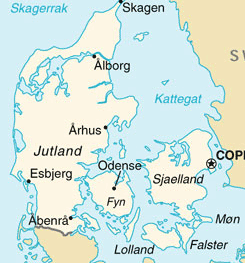Âûáåðèòå Âàø ßçûê
English Japanese German French Spanish Portuguese ChineseÎôèöèàëüíûå ôàêòû î Äàíèè

Êàðòà Äàíèè
Ââåäåíèå
Ñòðàíà Äàíèÿ ïðè÷óäëèâî ðàñïîëîæåíà íà êàðòå çàïàäíîé Åâðîïû. Îíà èìååò î÷åíü èíòåðåñíóþ ôîðìó è êàê áóäòî ïîëóîñòðîâ íåìíîãî òÿíåòñÿ ê Øâåöèè.  ìîðå âîçëå Äàòñêîãî ïîáåðåæüÿ ðàñïîëîæåíî îêîëî 400 íåáîëüøèõ îñòðîâêîâ è òîëüêî íà íåêîòîðûõ èç íèõ ïðîæèâàþò ëþäè.
Çíàåòå ëè âû, ÷òî Äàíèÿ ýòî ñàìàÿ ñòàðåéøàÿ ìîíàðõèÿ âî âñåì çàïàäíîì ìèðå. Äî íà÷àëà 19 âåêà Äàíèÿ çàíèìàëà âåñîìîå ïîëîæåíèå è ÿâëÿëàñü îäíîé èç âàæíåéøèõ ñèë â Ñåâåðíîé Åâðîïå.
Êðàòêèé îáçîð
Èçíà÷àëüíî Äàíèÿ çíàìåíèòà êàê êîëûáåëü âèêèíãîâ à ïîçæå êàê âåñîìàÿ ñåâåðîåâðîïåéñêàÿ äåðæàâà! Êîðîëåâñòâî Äàíèÿ ÿâëÿåòñÿ ïðîöâåòàþùåé íàöèåé, êîòîðàÿ àêòèâíî ïðèíèìàåò ó÷àñòèå â ïîëèòè÷åñêîé è ýêîíîìè÷åñêîé èíòåãðàöèè â ñîâðåìåííîé Åâðîïå. Äàíèÿ îñòàâàëàñü íåéòðàëüíîé â ïåðâîé ìèðîâîé âîéíå, íî áûñòðàÿ îêêóïàöèÿ ñòðàíû íàöèñòñêîé Ãåðìàíèåé â 1940 ãîäó óáåäèë áîëüøèíñòâî äàò÷àí, ÷òî íåéòðàëèòåò íå ÿâëÿåòñÿ íàä¸æíîé ãàðàíòèåé áåçîïàñíîñòè.  1949 ãîäó Äàíèÿ âñòóïèëà â ÍÀÒÎ à â 1973 ïðèñîåäèíèëàñü ê Åâðîïåéñêîìó ñîþçó. Äàíèÿ îñòàâèëà çà ñîáîé ïðàâî èìåòü ñîáñòâåííóþ âàëþòó.
Ãåîãðàôèÿ Äàíèè
- Êîîðäèíàòû: 56 00 N, 10 00 E
- Ìåñòîíàõîæäåíèå: Ñåâåðíàÿ Åâðîïà, ãðàíè÷èò ñ Áàëòèéñêèì è Ñåâåðíûì ìîðåì, ðàñïîëîæåíà íà ïîëóîñòðîâå ê ñåâåðó îò Ãåðìàíèè (ïîëóîñòðîâ Þòëàíäèÿ), êîòîðûé òàêæå âêëþ÷àåò â ñåáÿ äâà îñíîâíûõ îñòðîâîâ (Ôþí è Øåëëàíä).
- Ïëîùàäü Äàíèè: Îáùàÿ ïëîùàäü Äàíèè 43094 êâ. Âîäíûå ãðàíèöû 700 êâ êì. Âêëþ÷àÿ ïîëóîñòðîâ Þòëàíäèÿ, êðóïíûå îñòðîâîâà Øåëëàíä è Ôþí, à òàê æå îñòðîâ Áîðíõîëüì, íî èñêëþ÷àÿ Ôàðåðñêèå îñòðîâà è Ãðåíëàíäèþ. Òåððèòîðèÿ-42394 êâ êì.
- Coast line of Denmark : 7314 km.
- Climate: Windy winters and cool summers, temperate, humid and overcast; mild.
- Terrain: low and flat to gently olling plains.
- Elevation extremes: lowest point- Lammefjrd = -7m; Highest point- Yding Skovhoej = 173m.
- Natural hazards: flooding is a threat in some areas of the country except parts of Jutland, along the southern coast of the island of Lolland that are protected from the ocean by modern system of dikes.
- Natural resources: Gravel and sand, stone, limestone, petroleum, natural gas , fish , salt.
53% arable land ; 0,20 permanent crops. - Environment : air pollution, principally from vehicle and power plant emissions; drinking and surface water becoming polluted from animal wastes and pesticides, nitrogen and phosphorus pollution of the North Sea.
Population of Denmark
- Population of Denmark (Estimated ) for July 2006 is 5,450,700
About 1/4 of the population lives in Copenhagen. - Ethnic groups: Scandinavian, Inuit, German, Faroese, Turkish, Iranian, Somali.
- Religions: Evangelical Lutheran 95%, other Protestant and Roman Catholic 3%, Muslim 2%
- Speaking Languages: Danish, Faroese, Greenlandic ( dialect ), German (just a little ). People of yang age mostly can speak English . English is dominant foreign language. ( Do you need to learn Danish? )
Economy of Denmark
All facts about Economy of Denmark. - Denmark is a net exporter of food and energy and can easily enjoy with comfortable balance of payments surplus. The Danish government has been successful in meeting, and even exceeding, the economic convergence criteria for participating in the third phase ( Common European Currency ) of the European Economic and Monetary Union (EMU ), but Denmark has decided not jointo 12 other EU members into euro. Economical features of Denmark
- GDP ( Purchasing power parity ): 189,3 billion USD
- GDP per capita 34800 USD ( 2005 )
47390 USD ( 2006 ). - GDP real growth rate : 3,4%
- GDP composition by sectors:
Services = 74%,
Industry = 24%,
Agriculture = 3%, - Labor force: 2,9 million people.
- Labor force occupation:
Services = 76%,
Industry = 21%,
Agriculture = 3%, - Unemployment rate: 5,9%
( One of lowest in the world ) - Budget revenue: 144 billion USD.
Government of Denmark
All facts about Government of Denmark.- Official country name:
Long form - Kingdom of Denmark
Short form - Denmark
Local long form - Kongeriget Daanmark
Local short form - Danmark - Government type: constitutional monarchy
- Capital: Copenhagen
- Administrative division: Metropolitan Denmark - 14 counties
( amter, singular - amt ) and 2 boroughs
(amtskommuner, singular - amtskomunes ):
Arhus, Bornholm, Fredericksberg, Frederiksborg, Fyn, Kobenhavn, Kobenhavns, Nordjylland, Ribe, Ringk?bing, Roskilde, Sonderjylland, Storstrom, Vejle, Vestsjalland, Viborg. Also Faroe Islands and Greenland, which are part of the Kingdom of Denmark. They are self-governing administrative divisions. - Danish National holidays: National day 5th June ( Constitutional Day ) Original constitution was created in 1849 There was a major overhaul 5th June 1953 allowing for a unicameral legislature and a female chief of state.
- Independence: Denmark first was organized as a unified state in 10th century and in 1849 became a constitutional monarchy.
- Head of state: Queen MARGRETHE 2 ( queen since 14 January 1972 )
Heir Apparent Crown Prince FREDERIK, elder son of the monarch
( he was born 26 May 1968 ). - Head of government: Prime Minister ANDERS FOGH RASMUSSEN ( prime minister since 27 November 2001 )
- Council of state: appointed by the monarch
- Election: No elections, in Denmark the monarch is hereditary, Following legislative elections, the leader of the majority party of the leader of the majority coalition is usually appointed prime minister by the monarch.
- Judical Danish branch: Supreme Court (judges are appointed by the monarch for life ).
Name
Then
Don't worry -- your e-mail address is totally secure.
I promise to use it only to send you Discover Wonderful Denmark.



